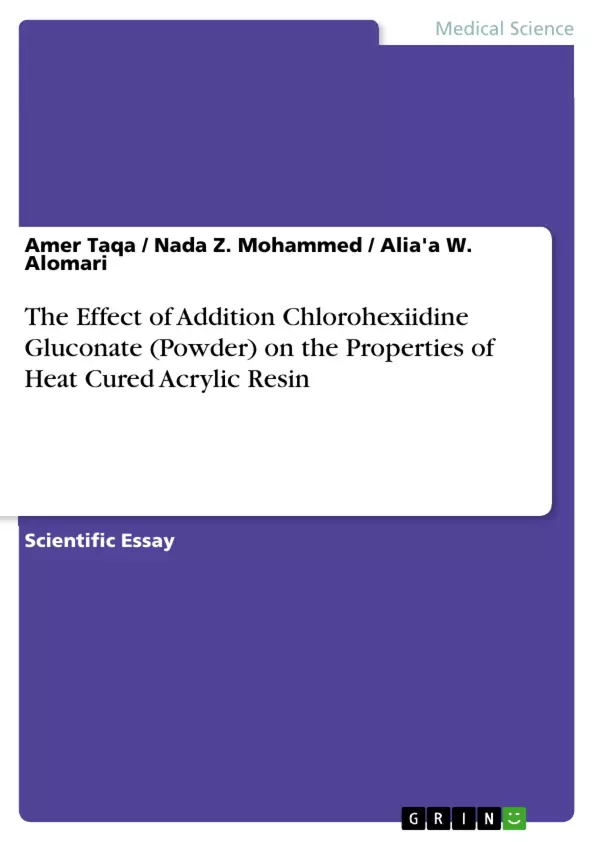This study aims to evaluate the effect of the addition of chlorohexidine gluconate (CHX) (powder) on some physical, mechanical properties and antimicrobial effect. In this study two hundred and forty samples of heat cured acrylic resin (Major base-2) were prepared and divided into different groups.
Control group (without the addition of CHX) and experimental groups (with the addition of CHX (powder) at (1%, 2%, 3%)) to evaluate transverse strength, tensile strength, surface hardness, dimensional accuracy, deflection, residual monomer in addition to antimicrobial effect for heat cured acrylic resin before and after the addition of CHX (powder).
Results showed a statistically significant difference at (p0.05) between control and experimental groups. The addition of CHX (powder) into heat cured acrylic resin increases its flexibility in addition to it's antimicrobial effect. Group of 1% CHX has the highest value of transverse strength, tensile strength, surface hardness and dimensional accuracy after control group.
In addition to its antimicrobial effect, CHX increases the flexibility of heat cured acrylic resin. As the concentration of added CHX increased, the flexibility of heat cured acrylic resin specimens will be increased.
Inhaltsverzeichnis (Table of Contents)
- ABSTRACT
- MATERIALS AND METHODS
- Control group:
- Experimental group:
- RESULLTS
- DISCUSSION
- CONCLUSION
- REFERENCES
Zielsetzung und Themenschwerpunkte (Objectives and Key Themes)
This study aimed to evaluate the effect of adding chlorohexidine gluconate (CHX) powder to heat-cured acrylic resin on various physical, mechanical properties, and antimicrobial effects. The study compared the control group (without CHX) to experimental groups with varying CHX concentrations (1%, 2%, and 3%).
- Effect of CHX on the physical and mechanical properties of heat-cured acrylic resin
- Evaluation of the antimicrobial effect of CHX in acrylic resin
- Assessment of the impact of different CHX concentrations on the properties of the resin
- Investigation of the relationship between CHX concentration and the flexibility of the acrylic resin
Zusammenfassung der Kapitel (Chapter Summaries)
The "Materials and Methods" chapter outlines the preparation and division of acrylic resin samples into control and experimental groups with varying CHX concentrations. The details of the experimental setup, including sample dimensions, testing procedures, and data analysis methods, are presented. The chapter also describes the specific tests conducted to evaluate different properties of the acrylic resin, such as transverse strength, tensile strength, surface hardness, dimensional accuracy, residual monomer, and antimicrobial effect.
The "Results" chapter presents the findings of the study, including statistical analysis of the data collected from the different tests conducted. The results indicate that the addition of CHX to heat-cured acrylic resin significantly influences its properties. Notably, the 1% CHX group demonstrated the highest values in transverse strength, tensile strength, surface hardness, and dimensional accuracy, suggesting a potential for improved resin performance with a lower CHX concentration.
The "Discussion" chapter provides an in-depth analysis of the results, exploring the implications of CHX addition on the flexibility and antimicrobial efficacy of the acrylic resin. The authors discuss the potential mechanisms behind the observed effects and offer insights into the optimal concentration of CHX for achieving a balance between improved resin properties and desired antimicrobial activity.
Schlüsselwörter (Keywords)
The study focuses on the effects of chlorohexidine gluconate (CHX) on the properties of heat-cured acrylic resin. Key themes include the impact of CHX on physical and mechanical properties such as transverse strength, tensile strength, surface hardness, and dimensional accuracy, as well as the antimicrobial effect of CHX in acrylic resin. The research also explores the relationship between CHX concentration and the flexibility of the resin.
- Quote paper
- Amer Taqa (Author), Nada Z. Mohammed (Author), Alia'a W. Alomari (Author), 2011, The Effect of Addition Chlorohexiidine Gluconate (Powder) on the Properties of Heat Cured Acrylic Resin, Munich, GRIN Verlag, https://www.grin.com/document/431815



